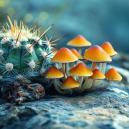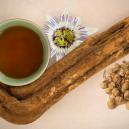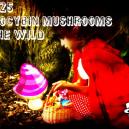25 Most Common Psilocybin Containing Mushrooms In The Wild
Published :
July 24th, 2017
Categories :
Products

Magic mushrooms have played an important part in the evolution of humans. They have been used for ceremonies by a number of indigenous people throughout the world. This is a Top 25 list of the most common psilocybin containing mushrooms in the wild.
PSILOCYBIN MUSHROOMS
Mushrooms that contain psilocybin can be found in many countries of the world. Archaeological digs often find examples of or reference to magic mushrooms. Commentators like the late Terence McKenna proposed that early hominids who ate magic mushrooms were inspired to create a complex language and religion, which then led to more intricate civilisations.
There is no denying that psilocybin is a wonderful compound, but please be careful when picking wild mushrooms.
Correct identification is important when dealing with fungi in general. There are some toxic species that resemble a number of magic mushrooms. Adverse reactions can range from mild nausea to anaphylaxis and sometimes even death. Please be 100% certain before ingesting anything not grown from identified spores. It is foolish at best and suicidal at worst to go into the wild, pick some unknown shrooms and eat them.
The mushroom you want to hunt will have specific conditions in which it thrives. Temperature, humidity, growing medium and time of year are all important factors. Knowing the life cycle of your target is also essential. The fruiting body usually only appears for a few months or every few years, depending on the parent mycelium.
Here is some more information about 25 psilocybin mushrooms in the wild.
25 MAGIC MUSHROOMS FOUND IN THE WILD
First, a shout out to a mushroom that doesn't contain psilocybin, but is famous globally for more reasons than being a trippy shroom. Think video games and cartoons about the adventures of small blue dudes. Amanita muscaria is doubtless the most infamous of the magic mushrooms.
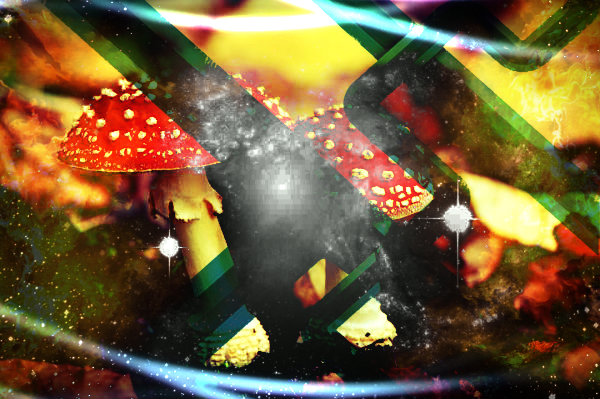
1: PLUTEUS SALICINUS
There are at least six species of Pluteus containing psilocybin:
- Pluteus cyanopus
- Pluteus glaucus
- Pluteus nigroviridis
- Pluteus villosus
- Pluteus brunneidiscus
- Pluteus phaeocyanopus
- Distribution: British Isles; Northern Europe; widely across the continental U.S.
- Identification: 3-7mm broad convex cap. Becomes more convex with age. Grey greenish to grey or salmon to salmon pink. Scaly near the centre, smooth at the cap’s edge. The stem is 40-100mm long and 2-6mm thick. White to grey-green, often turning blue. Flesh goes very blue when bruised, especially at the base. Unattached gills are pallid or salmon when matured with spores.
- Season: Late summer and early autumn, depending on seasonal rain.
- Habitat: Deciduous woodlands, especially alder (Alnus) or willow (Salix) or their woody debris.
- Dosage: Unknown.
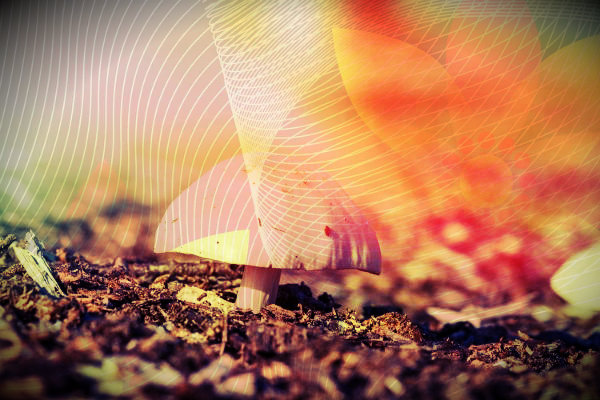
2: PSILOCYBE ANTIOQUIENSIS
- Distribution: At the time of writing, the only known habitats are Antioquia, Colombia; Vera Cruz and Jalisco in Mexico; Angkor Wat, Kampuchea.
- Identification: 5mm min to 30mm max diameter cap. Generally 10-15mm. Conic or globular at first, then convex as they mature. Orange brown to ochre orange. The edges have parallel grooves. Stem is 45-180mm long and up to 3mm thick. Gills are pale ochre to violet with white at the edges.
- Season: Monsoon season. May through to October.
- Habitat: Solitary or in small groups. Clay or sandy soil, especially in fields with cattle, horses, Brahman cattle or water buffalo. From manured soil, but not from the manure itself. Subtropical, humid, 1000-1600m elevation.
- Dosage: 15-20 fresh or 1-2g dried.
3: PSILOCYBE ATLANTIS
- Distribution: Fulton County, north of Atlanta, Georgia.
- Identification: 25-45mm diameter cap. Dry looking pale brown with darker striations. Generally convex, but sometimes concave like an inside out umbrella. Stem is 40-60mm long and 2-4 mm thick. Brownish red to greyish brown, covered in scales from cap to base. Blues when damaged. Gills are thin, brownish and coloured like the cap at the edges.
- Season: August.
- Habitat: Occurs in flocks in soils.
- Dosage: Unknown.
4: PSILOCYBE AUSTRALIANA
- Distribution: The state of South Australia.
- Identification: 16-30mm cap. Convex to bell shaped with slightly darker umbo at the centre. Fading from buff brown to pale yellow ochre at the edges. Margin may be blue tinged. Stem is 45-110mm long and 2-3mm evenly round. Bulbous base. Very blue after damage. Gills grow together - yellow or olive, then dark brown or purple with age.
- Season: April and May (southern)
- Habitat: Pinus radiata plantations. Temperate and subtropical rainforests. Grows on humus and leaf litter. Found bordering trails and roadsides.
- Dosage: One to two large fresh specimens. 1 dried gram.
5: PSILOCYBE AZTECORUM
- Distribution: Found only in the high mountains of Central Mexico. Rio Frio, Popocatépetl and Paso de Cortés, Nevado de Toluca and La Malinche. Puebla and Tlaxcala in the States of Mexico.
- Identification: 5-30mm diameter caps generally 15-20mm. Convex or bulbous, becoming striated when they expand. Yellow brown-yellow gold with minor blue bruising on the edges. Stalks are 55-75mm long and 3-5mm in diameter, thicker at the base. Stalks turn blue or greenish when bruised or late in maturation. Gills are light violet grey to dark violet brown and sometimes chocolate violet. They grow together and do not reach to the stem.
- Season: August through October.
- Habitat: Grows on soil with forest litter and twigs in gregarious groups of 5-20 specimens. Sometimes on very rotten logs at 3000-4200m elevation in Pinus hartwegii forests with long abundant grasses.
- Dosage: Unknown, but it has been used for centuries by indigenous Mexicans. The name aztecorum is in homage to the holy men who used these mushrooms in important ceremonies.
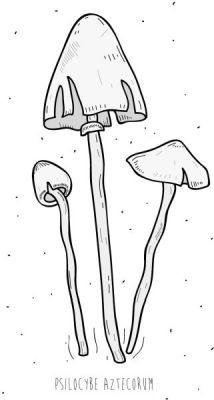
6: PSILOCYBE CAERULESCENS
- Distribution: Mexico; Brazil; Venezuela and Alabama.
- Identification: 2.5-9mm cap with a variation in colours. Black or deep green, cinnamon to rust. Cone shaped when immature with a curved-in margin. They flatten out and colours change when they age and expand. 35-100mm long stems are 3-5 mm in diameter, creme coloured, hollow and covered with fibrous hairs. The veil falls off in older specimens. Gills are close together and white at the edges. Light cinnamon turns to darker browns when matured.
- Season: Late spring and summer.
- Habitat: Rarely solitary, often growing dense like turf in clumps and tufts. Prefers mudslides and orange brown soils. Does not like competition from herbaceous species like grass.
- Dosage: 1-7 fresh mushrooms.
7: PSILOCYBE CUBENSIS
- Distribution: Cuba; Guatemala; Mexico; Honduras; South America; Vietnam; Cambodia; Malaysia; Myanmar; Thailand; Fiji; India; Phillipines and Australia. Several southern states in the U.S.
- Identification: 15-85mm cap generally 25-70mm. Copper coloured in the centre, fading to a light tawny brown. Cone shaped, becoming bell shaped, then expanding to a plain mushroom profile. 40-170mm stems generally 70-120mm long can be up to 18mm in diameter. Whitish or cream coloured and hollow, they blue easily when bruised. Remnants of the veil usually remain attached. The gills are dark grey when young and become deep violet or purplish as they age with mottled white edges.
- Season: Usually summer, but can vary from country to country.
- Habitat: Rarely grows solitary and fruits in tufts and groups usually in domestic cow or buffalo dung. Also pastures or meadows with rich soil and roadsides, but rarely on horse manure.
- Dosage: An ounce of fresh flesh. This can be 2 or 40 mushrooms. Average recreational dose is 1g dried or 5g for indigenous liftoff.
8: PSILOCYBE CYANESCENS
- Distribution: California to British Columbia, then on to Canada. Most of the Pacific Northwest. Austria; Belgium; Bulgaria; Czech Republic; UK; Germany; Netherlands; Italy; Ireland; Serbia; Spain; Switzerland. Single gregarious locations appeared in the last three years, then disappeared.
- Identification: 2-5cm cap. Cone shaped when young, convex as it expands and plain with a wavy margin when mature. Changing from chestnut to caramel with age. Sticky when moist. Yellowy brown or ochre when dried. Cap bruises blue or green when damaged or with age. 20-80mm long stems are 2.5-6mm in diameter. White with fine fibrils that curve to a broader base. Stems stain blue to violet green when damaged. The gills are attached to the stem, but grow thinner just before attaching. Cinnamon brown to dark smoky brown with pale edges.
- Season: September to December.
- Habitat: Scattered or dense clumps. Likes rich humus, woody debris, twig and leaf litter. Alder wood chips or bark mulch mixed with other local hardwoods. Thrives in shaded understories, briars and brambles, rose bushes, rhododendrons, ivy and strawberry bushes. Does not like cedar.
- Dosage: 1 large or 2-3 small specimens. Half a dried gram.
9: PSILOCYBE CYANOFIBRILLOSA
- Distribution: Northern California to British Columbia in Canada.
- Identification: 1-3.5cm cap. Cone shaped when young, becoming convex to very convex when mature, almost hemispherical. Chestnut brown with darker striations. Fades to yellowish brown or greyish white when dried. 30-70mm long stems are 2-4mm in diameter - straight, white and covered in thin fibrils and bulges at the base. Blue bruising when damaged. Gills grow together and become thinner before joining the stem. Light grey, aging to purple brown with white edges.
- Season: September to December
- Habitat: Scattered individuals or crowded colonies. Alder, willow and bush lupines in wood chips and tree litter. Common in rhododendron gardens and edges of flooded estuaries or floodplains.
- Dosage: 2-5 small or 1 large fresh specimen. Consuming dried not recommended as this species loses 70% potency during dehydration.
10: PSILOCYBE FIMETARIA
- Distribution: Oregon; Washington. British Columbia in Canada. Denmark; UK; Scandinavia.
- Identification: 0.5-6cm cap, generally 1-2.5cm. Cone shaped when young, develops into a convex bell. Turns broadly convex with a raised centre. Pale reddish brown, honey and deep ochre. Translucent when damp. Dries to yellowish olive or yellowish brown. Blue bruising when damaged. 20-90mm long stems generally 40-65mm. 0.5-4mm diameter, generally 2-3mm straight, hollow white, reddish brown or honey coloured with a bulbous end. Each stem has blue green to deep sea green tones and blue to dark green bruising when damaged. Gills grow together with a hook shape and are purplish brown with white edges.
- Season: October to December
- Habitat: Scattered individually or congregating in large rings. Grows well around horse manure and grassy areas with rich soils.
- Dosage: 15-30 of 14g fresh specimens or 1-2g dried.
11: PSILOCYBE LINIFORMANS
- Distribution: Washington; Oregon; British Columbia in Canada. Netherlands; Italy.
- Identification: 1-2.5cm, broadly convex with raised centre. Smooth, dull grey brown to olive brown. Sticky when moist. Bruises green blue. Fades to pale straw brown when dry. 14-30mm long stem 1-2mm diameter. White to pale brown bruising blue when damaged. Straight and swollen at base. Gills are dark chocolate to purplish brown.
- Season: Summer through autumn.
- Habitat: Individual, or tufts and clumps in horse manure or well manured pastures and fields.
- Dosage: Mildly active species. 10-20 live specimens.
12: PSILOCYBE SEMILANCEATA (LIBERTY CAP)
- Distribution: A very cosmopolitan species. Found in the UK and most of Europe, much of the U.S and throughout the world.
- Identification: 0.75-2cm cap. Is cone shaped and twice as high as it is broad with a pronounced nipple. Varying in colours from rusty brown to pale yellow with striated edges. Edges are translucent when moist and sticky to the touch. 40-100mm long stem is pale or rusty brown with a pronounced crook that can curl around a finger. The pithy stalk bruises blue after handling. Gills are crowded and purple brown. They thin before reaching the stem.
- Season: August through November and December.
- Habitat: Can be solitary or grow in dense tufts. Well manured pastures, tall rank grasslands and fields where cattle and sheep have grazed. They do not grow straight in manure. Along the Oregon coast, they have been collected from golf course roughs.
- Dosage: 20-40 fresh specimens or 1-2g dried. As a bulk guide, there are 30-40 doses in 500g fresh or 30g dried. First timers should limit their first try to 25 fresh specimens maximum.
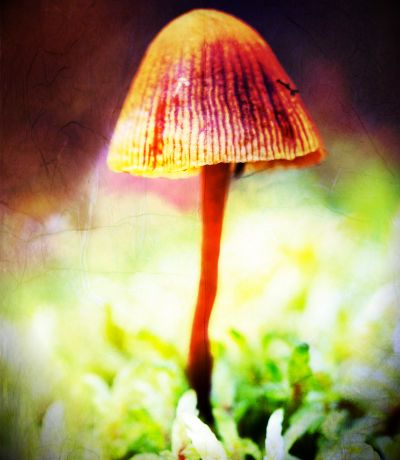
13: PSILOCYBE SILVATICA
- Distribution: Southern Oregon; British Columbia in Canada.
- Identification: 0.8-2cm broad, uneven conical cap with pronounced umbrate centre. Tawny dark brown and smooth, drying to a yellowish brown. Sticky thin cuticle when moist. 20-80mm long brittle stem. Dark brown, swelling slightly at the base. Gills vary in size and form a greyish brown to cinnamon or darker brown colour when older with white mottled edges.
- Season: Late September through December.
- Habitat: Well populated, but does not form mats. Grows on wood chips, especially alder detritus. Will grow on a substrate of decayed conifer.
- Dosage: 20-40g fresh or 2-4g dried.
14: PSILOCYBE PELLICULOSA
- Distribution: The U.S Pacific Northwest, British Columbia in Canada; Finland.
- Identification: 0.8-2cm sharp conical cap broadens as it ages. The name refers to the gelatinous film on the cap. Translucent radial striations divide the umber to a dingy yellow cap which dries to a pale yellow. 20-80mm long stems are 1.5-2mm in diameter, relatively straight with a slight bulge at the base. Gills are light cinnamon when young, then dark brown when mature, separating from the stalk.
- Season: September through December.
- Habitat: Cluster on moss, forest debris and rich humus in coniferous forests. The fruiting bodies can be found along forest trails and old logging tracks. Not usually found in grasslands.
- Dosage: This is a relatively weak mushroom. 20-50g fresh or 2-5g dried.
15: PSILOCYBE STRICTIPES
- Distribution: The U.S Pacific Northwest; Chile; The U.K.; France; Germany; Scotland; Slovakia; Sweden; Siberia.
- Identification: 5-30mm cap begins as a cone, becomes bell-shaped, then matures broadly convex. Smooth to the touch, walnut to rusty brown with radial translucent striations near the edges. Bruising blue when handled. There is a removable gelatinous membrane. 4-10cm long stems are only 0.25cm in diameter. Cream to light brown in colour and fibrous. Gills are cream coloured, maturing to purple and thinning as they attach to the stalk.
- Season: Late September to December.
- Habitat: Well manured lawns, open fields and pastures. Does not grow directly in manure.
- Dosage: Unknown.
16: PSILOCYBE SERBICA AKA BOHEMICA
- Distribution: Austria; Bosnia; Czech Republic; Germany; Greece; Netherlands; Hungary; Italy; Kosovo; Romania; Serbia; Slovakia; Slovenia.
- Identification: 2-4cm cap, conical when young. Becomes bell-shaped, then more broadly convex. Edges curve in when young and flatten with age. Buff brown to ochre brown, the caps dry to a pale ochre. Smooth and white to cream coloured, the cap has no gelatinous cuticle to remove. Bluish bruising when handled. 45-100mm long stems are 2-10mm in diameter - straight, hollow and bulging at the base. It is whitish with a silken gloss that loses its veil with age. Gills are close and often attach down the stem. Light brown when young, they become darker brown to purple with white edges when matured.
- Season: August through November and December.
- Habitat: Found growing in clusters in deciduous coniferous forests on decayed forest litter, leaf mulch, twigs and composts. Likes moist places along creek edges and bordering forest paths and trails.
- Dosage: Unknown, but psilocybin content is between 0.11-1.34%.
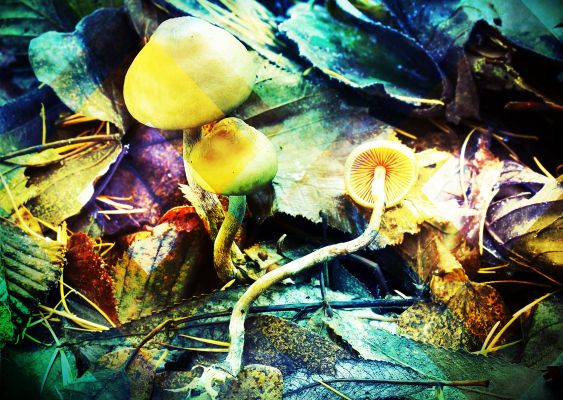
17: PSILOCYBE CAERULIPES
- Distribution: Northeastern U.S.; Cloud forests of Mexico.
- Identification: 1-3.5cm cap. Cone shaped when younger, then convex and broadly convex once matured. The edges are turned in at first, then flatten with age with a slight central nipple. Sticky at first with a gelatinous surface, which soon dries to be smooth. Cinnamon to dingy brown with a green tinge to the edges and a greenish tint overall. Blue bruising, but very slowly. 30-60mm long stems are 1.5-3mm in diameter, white or buff, relatively straight then bulging at the base. They slowly bruise blue and dry to a powdery blue. Each stem is pithy and solid and has a fine covering of whitish grey downward-facing fibrils. Gills are thin, crowded closely and vary in form. Some attach to the stem while others do not. Light brown, then maturing to deep cinnamon with white fringed edges.
- Season: Late May through to December.
- Habitat: Can be found singularly or in large mats in deciduous forests. Birch, beech and maple slash or wood chips and decaying plant matter. Found growing around rotted logs.
- Dosage: Unknown.
18: PSILOCYBE MEDULLOSA:
- Psilocybe silvatica is the American genetic cousin of Psilocybe medullosa.
- See description at #13
- Distribution: Generally throughout Europe.
- Identification: See above
- Season:
- Habitat:
- Dosage:
19: PSILOCYBE HEIMII
- Distribution: Subtropical forests of Mexico.
- Identification: 15-35mm diameter caps are convex when young, then more rounded and convex as they age. Dark brown to yellowy brown with edges that are tattered and lobular with translucent striations. Gills are dark brown to violet with pale edges. 50-80mm long stems are 1.5-3mm in diameter, white to brown or browny red, feathered with downy fibrils. Bruise deep blue to blackish when handled.
- Season: June to August
- Habitat: Individual or in small clusters on muddy soil in deciduous subtropical forests at 500-1,400m elevation.
- Dosage: Unknown. However, used by indigenous Mexicans for rituals and ceremonial rites for hundreds of years.
20: PSILOCYBE MORAVICA
- Distribution: Only in five locations in the Czech Republic.
- Identification: 2.5-3.5mm cap is conical when young, then swells to be semi-hemispherical. Then hemispherical and slightly bell-shaped with the margin joined to the stem with a fine white veil. Edges become mildly waxy and striated when moist. Changes colour quickly, sometimes bluish, sometimes bluish green with a blue dot in the centre. Dark brown when moist, then fading to yellowish brown or yellow ochre with blue tones. 50-90mm long stems are 2-5mm, cylindrical and with a distinct curve. White to off-white and lanky with a scabrous surface and no bulge at the bottom.
- Season: Late September to November/December, depending on temperatures.
- Habitat: In clusters on woody debris in deciduous or mixed forests. Often found where humans have cleared, then piled wood waste. Only reported at elevations of 230-700 metres.
- Dosage: Presently unknown.
21: PSILOCYBE NATALENSIS
- Distribution: Only collected in two localities 250km west of Natal in South Africa.
- Identification: 1-6mm cap is unevenly conical when young, then hemispheric, broad and convex. Yellowish to off-white with a bluish border, the colours do not change with age. 40-120mm long stems are 1-10mm in diameter. Smooth, dry, white, hollow and invariably curved. Easily stains blue, especially lower down on the stem. Undefined gills are buff when young, then purplish brown with a white edge when mature.
- Season: January.
- Habitat: Scattered in rich manure fertilized fields and pastures, but not directly in manure.
- Dosage: Reported to be similar to cubensis.
22 PSILOCYBE SAMUIENSIS
- Distribution: Koh Samui Island and surrounding areas in Thailand, including Ranong Province; Angkor Wat, Cambodia
- Identification: 1.5-7cm cap. Convex and bell-shaped, developing a raised papilla as it grows. Buff brown with a thin membrane of scum and translucent when moist. The edges are striated when young. 40-60mm long and 1-2mm diameter straight. Whitish yellow with fine fibrils. Partial veil disappears with age. Gills grow together, are golden brown, then dark violet brown with pale edges when aged.
- Season: Late May to September, sometimes October.
- Habitat: Manured clay soils, like rice paddies or grass fields.
- Dosage: Up to 20 fresh specimens.
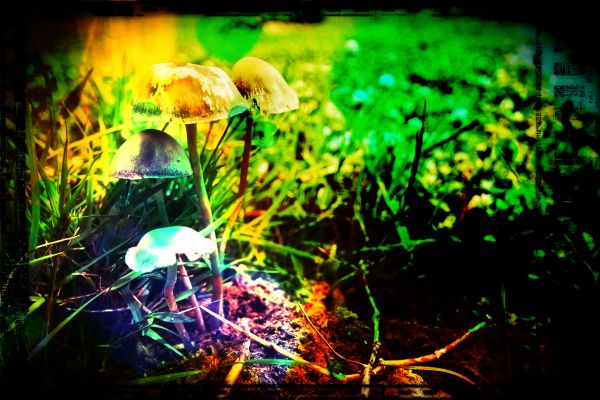
23: PSILOCYBE OVOIDEOCYSTIDIATA
- Distribution: To date, Pennsylvania; Ohio and West Virginia in the United States.
- Identification: 10-45mm cap, generally 15-25mm convex with a projecting central boss. Orange brown to yellow brown plaid when mature or dry. 15-90mm long stems generally 25-60mm and 1-10mm in diameter, cylindrical and slightly bulbous. Smooth with pale ochre and reddish tones above darker brown to violet hues. Scaly below. Bruises blue when damaged. Gills are uniform in colour, pale brown to deep brown violet.
- Season: April through August/September.
- Habitat: Among herbaceous plants in deciduous forests on forest litter and wood mulch. Along trails, stream banks and floodplains.
- Dosage: Treat as per cyanescens.
24: PSILOCYBE STUNTZII
- Distribution: North of San Francisco to Oregon in the U.S. and British Columbia in Canada.
- Identification: 15-50mm cap. Conical when young, expanding to flat, sometimes slightly convex with a raised centre. Dark chestnut brown or olive greenish, paling to the striated margins. Edges are translucent when moist. Sticky when moist from a gelatinous membrane. Fades to light yellow when dry. 30-60mm long stems are 2-4mm in diameter, hollow with a white pith. Easily bruises a pale blue colour where the cap scar is when handled. Gills are slightly broad, grow together and become thinner at the stem.
- Season: Late July through September for grassy areas and lawns. Late September to December in deeply mulched gardens. Can grow all year in some parts of the Pacific Northwest, depending on seasonal variations.
- Habitat: Grows in well-populated clusters in ader bark mulch and conifer wood chips. Appears in lawns of freshly laid sod and deeply mulched, woody debris.
- Dosage: 8g fresh or 20-30 specimens. 1-3g dried.
25: PSILOCYBE SUBCUBENSIS
- Distribution: This is a subtropical and cosmopolitan species. Found in Mexico; Bolivia; Colombia; Ecuador; Honduras; El Salvador; Australia; Nepal; India; Thailand; Cambodia; Vietnam and some of the Philippines.
- Identification: 18-50mm. Cone shaped when young, then very convex, maturing to plain. Centre is copper coloured, fading to light golden brown and pale yellow at the edges. Bruises blue at edges when injured. 50-80mm long stems are 4-6mm in diameter. Hollow and straight. Whitish to creamy white and pale yellow when older. Fibrous in the lower parts and easily stains blue when handled. Gills start dark grey, then become deep purple when mature and sporing. Mottled to white at the edges.
- Season: Generally in summer, but can vary from country to country.
- Habitat: Rarely solitary or scattered grows prolifically on cow dung, but not horse manure. Rich soils and pastures on roadsides and trails and in dung heaps.
- Dosage: 25g fresh or more. 1g dried to 3-5g for a full ceremonial dose.









